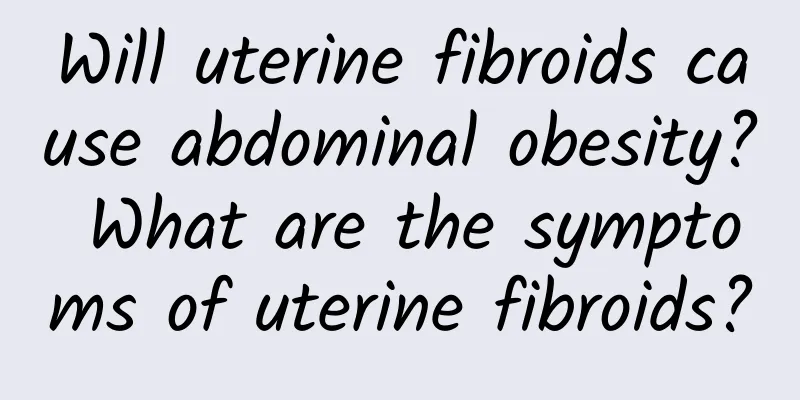Will uterine fibroids cause abdominal obesity? What are the symptoms of uterine fibroids?

|
It is reported that Ms. Huang, 53, began to notice that her stomach was gradually getting bigger more than 10 years ago. She didn't care because she had no symptoms. It was not until she went to the hospital for a check-up two months ago that she found a uterine fibroid in her abdomen, weighing 4 kilograms and as big as a basketball. The doctor said that it is rare for a patient's fibroid to grow to 25 centimeters and as big as a basketball without obvious symptoms. Benign uterine fibroids are usually smaller than 5 centimeters, asymptomatic, can be followed up regularly, and most do not require surgery. However, Ms. Huang's fibroids are quite large and must be surgically removed as soon as possible. Using traditional surgery to remove the tumor, the wound will be very large. At present, minimally invasive surgery technology has matured, and the wound is only 4 incisions of about 1 cm, with less bleeding and no damage to nerves and blood vessels. It can not only relieve the patient's pain, but also enable the patient to recover as soon as possible, which is particularly suitable for Ms. Huang. Ms. Huang's operation was very successful and she got up on the third day after the operation. What are the symptoms of uterine fibroids? The symptoms of uterine fibroids mainly include irregular menstruation, lower abdominal mass, increased leucorrhea, compression symptoms, back pain, etc. If you find these symptoms, you should pay attention to them to avoid aggravating the condition and affecting the treatment effect. The symptoms of uterine fibroids include the following: 1. Irregular menstruation Irregular menstruation symptoms of increased menstrual volume and prolonged menstruation are the most common symptoms of uterine fibroids. They are seen in large intramural fibroids and submucosal fibroids. Fibroids increase the uterine cavity, increase the area of the endometrium, and affect uterine contraction. In addition, fibroids may squeeze the veins near the tumor, causing congestion and dilation of the endometrial venous plexus, resulting in increased menstrual volume and prolonged menstrual periods. When submucosal fibroids are accompanied by necrotic infection, irregular vaginal bleeding or bloody purulent discharge may occur. Long-term increased menstrual volume may lead to secondary anemia, fatigue, palpitations and other symptoms. 2. Lower abdominal mass When the fibroids gradually grow larger and the uterus is pregnant for more than 3 months, the mass cannot be touched in the abdomen. The huge submucosal fibroids can be separated from the vagina, and the patient can be separated from the mass because of the vulva. 3. Increased leucorrhea Intramural fibroids increase the area of the uterine cavity, increase endometrial gland secretion, and are accompanied by pelvic congestion, leading to increased leucorrhea; once the submucosal fibroids of the uterus are infected, there will be a large amount of purulent leucorrhea. If there is ulceration, necrosis, or bleeding, there may be bloody or purulent, foul-smelling vaginal discharge. 4. Compression symptoms Myomas in the lower part of the anterior uterine wall can compress the bladder, causing frequent urination and urgency; cervical myomas can cause dysuria and urinary retention; uterine posterior wall myomas (canyon or posterior wall) can cause symptoms such as lower abdominal swelling and discomfort, constipation, etc. Broad ligament myomas or giant cervical myomas develop laterally, compressing the ureter in the pelvic cavity and blocking the upper urinary tract, leading to ureteral dilatation and even hydronephrosis. 5. Other symptoms These symptoms include lower abdominal distension, back pain, and worsening menstrual symptoms. Acute lower abdominal pain, vomiting, fever, and local tumor tenderness. Subserosal myoma pedicle torsion can cause acute abdominal pain. Submucosal myoma can also cause abdominal pain. Submucosal and intramural myomas that deform the uterus can cause infertility or miscarriage. |
<<: Can multiple uterine fibroids cause miscarriage? How to treat uterine fibroids?
>>: What medicine is better for uterine fibroids? How to use medicine for uterine fibroids
Recommend
How can women prevent cervical erosion? Women should keep in mind 5 points to stay away from cervical erosion
Cervical erosion, mild cases often have no obviou...
The main symptoms of perimenopausal syndrome
Perimenopausal syndrome generally refers to perim...
Can I get pregnant with uterine fibroids?
It is possible to get pregnant with uterine fibro...
Burning fat requires high CP value to increase the effect of exercise
I have been running on the treadmill for 30 minut...
How to increase menstrual flow
How to increase menstrual flow? Increasing menstr...
Have you ever heard of hyperplastic vulvar leukoplakia?
Do you know about hyperplastic vulvar leukoplakia...
Is cervical erosion hereditary in women?
Is cervical erosion hereditary for women? Everyon...
How long after a miscarriage can I wash my hair? Listen to the doctor
After a woman has an abortion, her body usually n...
Drinking more water to lose weight really helps reduce fat calories
For people who want to lose weight, often heard a...
What to do if you want to have an abortion due to adenomyosis
It is generally believed that severe adenomyosis,...
Thin legs this way! 2 Yoga poses for beautiful legs and firm lines
Do the thick saddlebag flesh on the inner thighs ...
The most common symptoms of pelvic inflammatory disease
Among the gynecological inflammatory diseases, pe...
Can premature ovarian failure eat coix seed?
Patients with premature ovarian failure can eat c...
Why do women have black dirt during menstruation?
Women sometimes see that the color of their menst...
What are the symptoms of cervical erosion? Why is there tofu dregs after taking medicine for cervical erosion?
Cervical erosion is a common problem among female...









